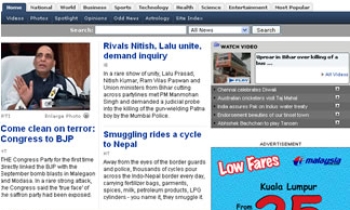It was the tsunami of December 24, 2004 which opened the floodgates. For the first time, accounts of a major news event authored by citizens with no professional journalism experience not only made front page news or headlining nightly broadcasts, they achieved recognition in the news industry and the world-at-large as valid and credible sources.

"Each new natural disaster, act of terrorism, government crisis, or polarising national issue fuels the growth of citizens commenting, reporting, or illustrating via text, pictures, videos, or audio their unique perspectives on current events, " says A Guide to Citizen Journalism for Newspaper Executives, published by the International Newspaper Marketing Association.
The INMA report discusses how the growing trend can become a conduit for the reader interactivity that previously was the end-result of the news experience for consumers, and now serves as the start of a dialogue that is shaping the future of news. The report examines common examples of citizen journalism at today's newspapers, including blogs, citizen reporters, and advances in mobile telephony as a developing avenue in newspapers' interactions with readers. It also examines the changing reader landscape; consumers' evolving expectations of the news media and how they interact with it.
Andreas Berens, head of communications, and Constanze Hess, head of business development, both at Germany's Rheinische Post, have identified seven advantages for newspapers that use citizen journalism:
- Relevance: Content generated by other readers, versus newspaper staff, is perceived as being more relevant to consumers' lives.
- Voluntary: Consumer-generated content is published voluntarily by readers, limiting expenditures on the part of the newspaper.
- Professional: Stories and photographs can be of the same high quality as those produced by professional journalists and photographers.
- Connections: The common forum connects readers to each other.
- Target Groups: Audiences attracted by such content are typically relevant and homogenous target groups for advertisers.
- Complementary: Stories created by users frequently complement news reported by traditional journalists.
- Competition: However, it does not compete with traditional journalism as a news source.
The report points out new types of newspapers that are springing up all over the world that have no print counterpart, rely heavily on participatory journalism, and concentrate coverage to local news. In some cases, the focus is hyper-local such as what is happening in citizens' neighbourhoods or on their streets.
Voice of San Diego in San Diego, California, Barcelonareporter.com based in Barcelona, Spain, and Japan's JanJan are three examples of a growing niche in online-only news publishing that couples the values of old-style journalism with the ideals of reader participation. "These online news sources are creating new business models that publishers see as the future of a new journalism partnership between media organisations and citizens," writes Marisa Treviño, one of the authors of the report.
Cost-cutting is also playing a role in news organisations' interest in citizen journalism. Budgetary pressures are forcing some newspapers to shutter their bureaus abroad, such as the Baltimore Sun's closure of its London and Beijing offices. With fewer newsgathering teams positioned in the field, more and more the news media will find itself ill-prepared to respond to fast-breaking events. "Citizen journalism initiatives can offset some of this loss in coverage," says James Khattak, another author.

New websites taking a populist slant on journalism too are now being launched all the time. NowPublic is an Internet news service where members assign citizen journalists and photographers to cover stories remotely. NowPublic's chief executive officer, Michael Tippett, told INMA: "A nexus of hyper-local news producers is a highly refined index of what people care about at any given moment. But simply aggregating the interests of droves of citizen journalists, even at the most local levels, may present the same challenge confronted by news executives: What stories do the most people care most about?"
NowPublic members indicate their interest in published stories or even in requests for coverage by voting to acord priority to the ones that interest them the most. By voting, members elevate its rank in the request queue, increasing the chances that others close to the story see it and respond by submitting footage or more details. Developing stories are sorted by the number of votes they receive so news readers see the most popular stories at the top of the page, and can, in turn, cast votes to show their interest in stories they care about.
The report concludes, "The next generation of newspaper reader will not be a passive consumer. Going forward, newspapers will contend not only with television, radio, or the internet, but with their readers as well. Forward thinking newspaper companies have protected themselves and diversified their products by acquiring television and radio stations, along with, moving onto the Internet. Those same forward-thinking newspapers will embrace citizen journalism as well."









